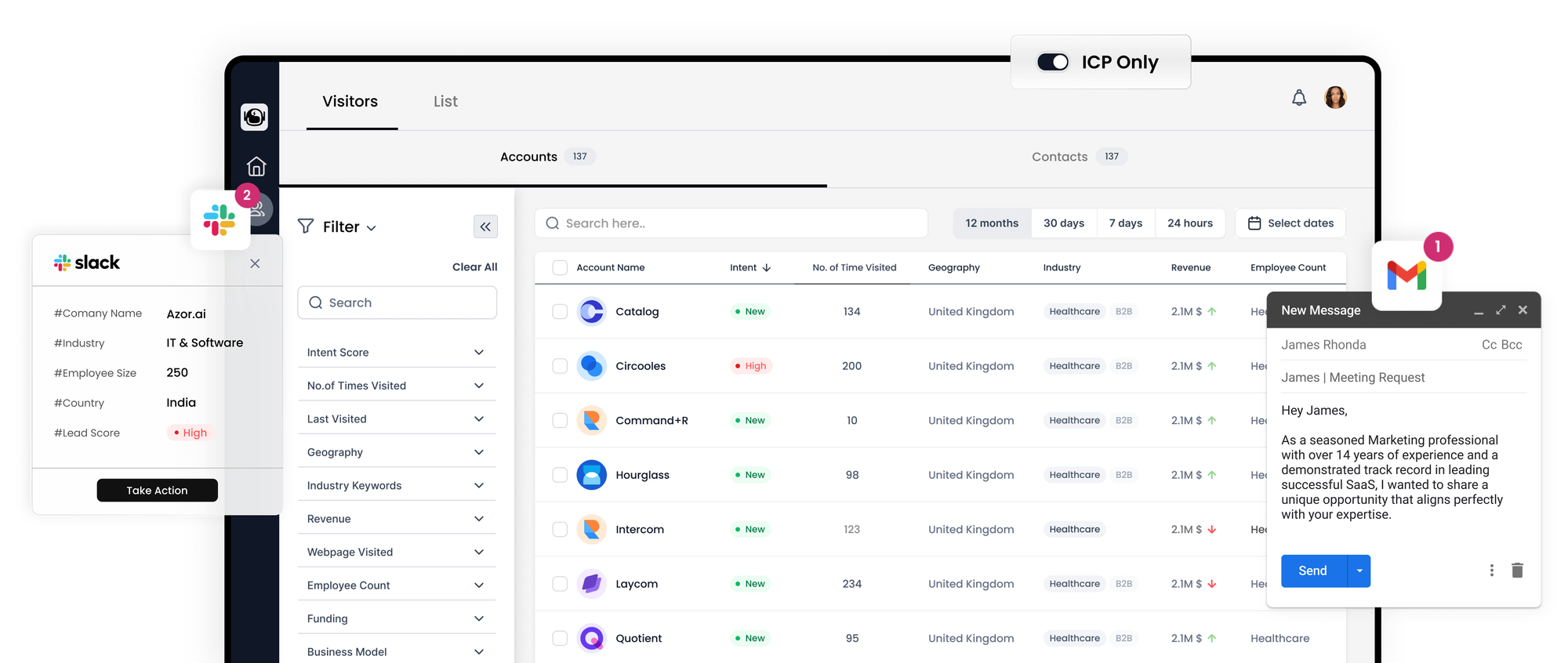Developing a Robust Demand Generation Strategy: Key Approaches and Examples

Demand generation is a critical component of B2B marketing strategies, focusing on creating awareness and interest in a company's products or services. Unlike the common misconception, it's not solely about creating a product or service and expecting it to sell itself. It involves a series of strategic actions to build and nurture a qualified audience for your offerings. This guide will delve into crafting an effective demand generation strategy, distinguishing it from lead generation, and exploring its key aspects with examples from successful companies.

Understanding Demand Generation
1. Defining Demand Generation
- Demand generation is about stimulating interest and demand for your products or services. It involves strategic marketing efforts to capture attention and engage potential customers, even before they have tried your product or service.
- It differs from lead generation, which is about initiating consumer interest or inquiry into your business. While they overlap, demand generation is a broader concept encompassing brand awareness and customer engagement.
2. Key Metrics for Success
- A successful demand generation strategy relies on clearly defined success metrics. These metrics might include engagement rates, lead quality, conversion rates, and ROI.
3. Tactics and Examples
- Effective demand generation strategies use a variety of tactics across multiple channels. These may include lead scoring, display retargeting, sponsored research, and partner webinars.
- For instance, companies like Pardot and Salesforce utilize sponsored research and webinars to both create demand and generate leads.
Crafting a Demand Generation Strategy
1. Sales and Marketing Cooperation
- Demand generation requires collaboration between sales and marketing teams. It is a data-driven process that aims to nurture prospects over the long term, engaging them through various platforms and touchpoints.
2. Phase-by-Phase Breakdown
- The strategy should cover every phase of the demand generation funnel, focusing on optimization and sales creation.
- Tactics might include sponsored white papers, newsletters, meetups, and company-sponsored webinars.
3. Inbound Marketing and Lead Nurturing
- While inbound marketing tactics like blogging, email lists, and social media are integral to demand generation, they represent only a part of the larger strategy.
- Demand generation also involves nurturing potential prospects and guiding the best-qualified leads to the sales department, facilitating higher conversion rates and sales.
4. Identifying and Targeting Touchpoints
- The strategy should identify the best touchpoints to engage customers effectively.
- Strong demand can be generated for new or existing prospects by strategically targeting touchpoints that resonate most with the target audience.
In summary, an effective demand generation strategy requires a holistic approach that spans various marketing tactics and channels. It's about creating a system that not only generates interest but also nurtures potential customers through their journey, ensuring a steady supply of qualified leads to the sales team. By understanding and implementing these strategies, businesses can significantly enhance their marketing efforts, leading to increased awareness, engagement, and ultimately, sales. With the right approach, tools, and collaboration between sales and marketing, demand generation can transform the way businesses attract and retain customers.
Developing an Effective Demand Generation Strategy: Steps, Metrics, and Nurturing Techniques
Demand generation is a critical process for B2B companies, requiring strategic planning, coordination between sales and marketing teams, and a deep understanding of the customer journey. This comprehensive guide outlines how to create a successful demand generation strategy, including setting goals, utilizing key metrics, and nurturing leads effectively.
Setting the Foundation for Demand Generation
1. Defining Success Metrics
- Begin with a clear definition of what success looks like in your demand generation strategy.
- Assess the quality of leads generated and determine if they are worthwhile or need improvement.
- Understand that demand generation tactics should align with every stage of the customer journey.
2. Importance of Sales Metrics
- According to HubSpot, 74% of companies not meeting revenue goals lack knowledge of their visitor, lead, and sales opportunity metrics.
- Properly tracking these metrics allows for more targeted and effective demand generation tactics.
Key Metrics and Strategies for Demand Generation
1. Email Subscribers
- While abundant, email subscribers vary in value. Segmentation is key to making your emails relevant.
- Consider factors like signup date, specific links, clickthroughs, and user responsiveness for effective segmentation.
2. Marketing Qualified Lead (MQL)
- MQLs are prospects who have shown interest in your product or service.
- Sales and marketing teams must agree on what constitutes an MQL, focusing on factors like job titles, industries, and company sizes.
3. Sales Qualified Lead (SQL)
- SQLs are vetted leads displaying buying behavior.
- Utilize criteria like Budget, Authority, Need, and Timeframe (BANT) to assess a lead’s readiness and capacity to purchase.
4. Sales Opportunity and Opportunity Won
- Sales opportunities are high-value leads with a high probability of closing.
- After winning an opportunity, continue engaging customers through newsletters, loyalty programs, and feedback surveys.
Lead Scoring and Nurturing for Enhanced Demand Generation
1. Lead Scoring
- Implement lead scoring to target the best leads in your funnel.
- Rank leads based on criteria such as job position, social media followers, and company size.
2. Lead Nurturing
- Lead nurturing involves developing relationships with prospects at every stage of the sales funnel.
- Guide leads intuitively along the buyer’s journey using indicators like website visits and content downloads.
3. Types of Leads in Lead Nurturing
- Categorize leads into types like Good Fit and Interested, Good Fit but Less Interested, Not a Good Fit but Interested, and No Fit and No Interest.
- Tailor your nurturing strategies based on these categories for more effective engagement.
Implementing an Effective Demand Generation Strategy: Techniques and Best Practices
Demand generation is a crucial part of any B2B marketing plan, requiring a thoughtful and multi-faceted approach. It's not about the simplistic belief that 'if you build it, they will come'; instead, it demands a strategic effort to attract, nurture, and convert leads into customers. This guide covers essential demand generation techniques, examples from leading companies, and key takeaways for marketers.
Starting with Lead Scoring
Defining Marketing Qualified Leads (MQLs)
- Collaboration between marketing and sales is vital to define what qualifies as an MQL for your company.
- Consider demographics, activities, and behaviors that indicate a lead's potential to purchase.
- Use lead scoring to prioritize leads based on their potential value to your business.
Techniques for Enhanced Demand Generation
1. Display Retargeting
- Example: Pardot uses retargeting to maintain brand visibility throughout the buying cycle.
- Retargeting is effective for keeping your brand in front of decision-makers, leading to increased revenues.
2. Sponsored Research
- Example: HubSpot leverages sponsored research to establish itself as a thought leader.
- Investing in unique and valuable content helps differentiate your brand and attract more qualified leads.
3. Free Resources for Lead Generation
- Example: Wordstream’s Adwords Performance Grader.
- Offering free resources establishes your brand as a thought leader and engages a wide range of leads.
4. Video Advertising
- Example: Box uses video advertising to quickly and effectively communicate the benefits of its services.
- Videos are engaging and can significantly enhance SEO, landing page conversions, and social media sharing.
5. Partner Webinars
- Example: Wordstream and Moz collaboration.
- Webinars are excellent for sharing insights and boosting brand awareness, especially when partnered with industry influencers.
6. Syndicated Content
- Example: Salesforce's widespread blog post syndication.
- Distributing content through third-party media channels can significantly increase brand awareness and establish thought leadership.
7. Display Retargeting for Brand Awareness
- Example: Wordstream’s increase in repeat visitors and conversion rates through retargeting.
- Retargeting not only boosts conversions but also serves as a powerful tool for maintaining brand visibility.
8. Aligning Marketer Metrics with Goals
- Ensure that the publishers or partners you work with understand and align with your lead quality goals.
- This alignment helps in acquiring leads that are more likely to convert into MQLs.
9. Targeting Prospects with Appropriate Content
- Tailor your content to attract high-quality late-stage leads.
- Focus on content like buyer guides, case studies, and webinar registrations that appeal to prospects closer to a purchasing decision.
Key Takeaways for Marketers
- Abandon the 'build it and they will come' mindset. Demand generation requires a long-term commitment to customer engagement.
- Select and repurpose content that resonates with your target audience. Use evergreen or timely content that addresses current pain points.
- Distribute your messaging through appropriate channels. Consider using syndicated content, videos, webinars, or display ads for broader reach and impact.
- Remember, demand generation is about building lasting relationships with customers, not just acquiring new leads. Your strategy should be comprehensive, covering all stages of the buyer's journey.
In conclusion, a robust demand generation strategy involves multiple tactics and a deep understanding of your target audience. By implementing these techniques and learning from successful companies, you can effectively generate demand, nurture leads, and ultimately drive more sales for your business. The goal is to create a sustainable strategy that not only attracts leads but also fosters long-term customer relationships.
